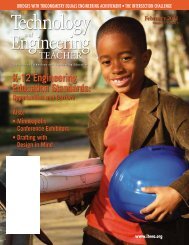Teaching Elements and Principles of Bridge Design - International ...
Teaching Elements and Principles of Bridge Design - International ...
Teaching Elements and Principles of Bridge Design - International ...
Create successful ePaper yourself
Turn your PDF publications into a flip-book with our unique Google optimized e-Paper software.
TEACHING ELEMENTS AND<br />
PRINCIPLES OF BRIDGE DESIGN<br />
FEATURE ARTICLE<br />
Charles Beck<br />
<strong>Bridge</strong> construction is a popular<br />
classroom activity. However, the<br />
basic principles <strong>of</strong> tension,<br />
compression, <strong>and</strong> counterbalance are<br />
not always clearly represented <strong>and</strong><br />
defined. The common materials used<br />
to construct model bridges, such as<br />
straws, toothpicks, Legos, <strong>and</strong><br />
building blocks, are <strong>of</strong>ten too flexible<br />
or stationary to demonstrate the<br />
principles that keep bridges upright<br />
<strong>and</strong> functional. If the basic principles<br />
are not clearly demonstrated,<br />
students will fail to underst<strong>and</strong> how<br />
bridges are able to support heavy<br />
loads. Upper elementary <strong>and</strong> middle<br />
school students can design simple<br />
models that demonstrate the<br />
essential elements <strong>and</strong> basic<br />
principles <strong>of</strong> bridge design.<br />
ITEA St<strong>and</strong>ards<br />
<strong>Design</strong>ing model bridges addresses<br />
several <strong>of</strong> ITEA’s St<strong>and</strong>ards for<br />
Technological Literacy (ITEA,<br />
2000/2002). For example, by<br />
identifying basic elements <strong>and</strong><br />
principles <strong>of</strong> bridge design, students<br />
develop an underst<strong>and</strong>ing <strong>of</strong> the<br />
“attributes <strong>of</strong> design” (St<strong>and</strong>ard 8)<br />
<strong>and</strong> “engineering design” (St<strong>and</strong>ard<br />
9). Students “select <strong>and</strong> use<br />
constructive technologies” (St<strong>and</strong>ard<br />
20) when they design model bridges<br />
<strong>and</strong> test their ability to support loads.<br />
Most states have Instructional<br />
Frameworks or St<strong>and</strong>ards that require<br />
classroom teachers to expose their<br />
students to the basic physical<br />
principles <strong>of</strong> engineering <strong>and</strong><br />
technology. Based on the<br />
By designing model bridges, students can<br />
begin to appreciate how engineers construct<br />
elements that produce tremendous force,<br />
such as arches <strong>and</strong> cables.<br />
Figure 1: Arch <strong>Bridge</strong> Construction <strong>Principles</strong> <strong>and</strong> <strong>Elements</strong><br />
constructivist theory to learning,<br />
students need to design models to<br />
underst<strong>and</strong> these principles.<br />
Materials<br />
The drawings illustrate two common<br />
types <strong>of</strong> bridges—the arch <strong>and</strong> the<br />
suspension. The arch bridge (see<br />
Figure 1) may be constructed from<br />
Styr<strong>of</strong>oam or wooden wedges. Paper<br />
clips or cotter pins are used to secure<br />
the abutments. To prevent the<br />
wedges from wobbling, they should<br />
be about two inches in thickness.<br />
The suspension bridge (see Figure 2)<br />
is constructed from balsa for the<br />
towers, deck, <strong>and</strong> anchorages. The<br />
illustration shows short side decks<br />
<strong>and</strong> cable spans. The students may<br />
want to lengthen the side decks <strong>and</strong><br />
their cable spans to resemble an<br />
actual suspension bridge. The cables<br />
<strong>and</strong> suspenders are made from paper<br />
clips linked together. In order to show<br />
tension, the deck should only be<br />
1/16” to 1/8” in thickness. The tower<br />
framework is about 1/4” in thickness.<br />
The paper clips or pins must pass<br />
through the abutments <strong>and</strong><br />
anchorages <strong>and</strong> into the baseboard.<br />
Students may use glue or paper clips<br />
to secure the tower cross beams to<br />
the uprights <strong>and</strong> the foundations to<br />
the baseboard. It should not be<br />
difficult to push paper clips through<br />
balsa. These materials are available<br />
in most arts <strong>and</strong> crafts supply stores.<br />
6 April 2005 • THE TECHNOLOGY TEACHER
















